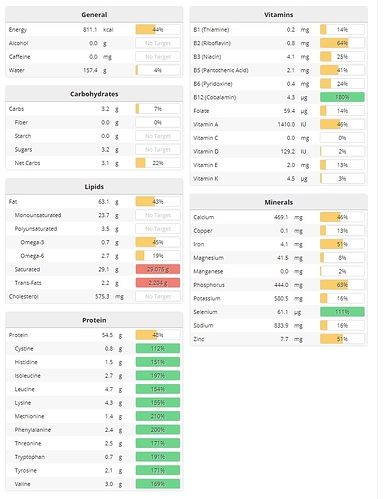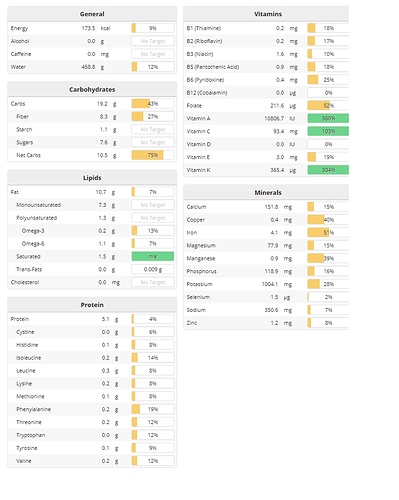So I got involved in a discussion about diet elsewhere. Most people there are praising a low fat, high carb diet. I want to introduce them to the nutrient values of Keto, but I don’t know where to find an easy to copy, easy to understand chart of nutrients. These are total newbies, but smart folks. Can anyone help?
Help with basic nutrient chart
I’m not sure what you mean by this. Are you talking about a macro nutrient chart (e.g. carb/protein/fat), or are you talking about some kind of “keto RDA” which encompasses dozens of micro nutrients, amino acids, lipids, etc? Or perhaps something else altogether?
I am trying to show them that you can get all the necessary nutrients from a keto diet. The opinion there is that you need to eat mostly veggies and some lean protein, along with grains, to get enough life supporting nutrients in the long run. I.e. vitamins, minerals and all the things that tend to be common knowledge. @Don_Q
This is actually something that I find funny these days. We are told that plants are filled with essential nutrients because otherwise it’s hard to see much point in eating them since they have a much crappier protein profile than meat.
Now it’s true, they do have some essential nutrients, but they don’t have any essential nutrients that are not also in meat sources. And, in fact, in many cases those nutrients in plants are in a far less bioavailable form and our bodies either have to use more energy to get them less efficiently or fail entirely to take them up at all because some other plant compound is binding to it.
Further, this binding effect can impact ones uptake of dietary nutrients regardless of the source. In other words, you can eat something like mussels that are high in zinc and have some grain with it and you won’t get hardly any of the zinc compared to if you had eaten the mussels alone.
Finally, the idea that we need grains for nutritional value is even more ludicrous. Yeah, there are lots of great nutrients in flour…because we put them there. Prior to the beginning of flour fortification the basic American diet was leading to all sorts of disease states.
“In the 1930s and 1940s specific deficiency disease syndromes were first identified and documented in the United States (Foltz et al., 1944; McLester, 1939; Williams et al., 1943). Based on this new science, in 1940 the Committee on Food and Nutrition (now the Food and Nutrition Board [FNB]) recommended the addition of thiamin, niacin, riboflavin, and iron to flour (NRC, 1974). About that time FDA first established a standard of identity for enriched flour that identified specific nutrients and amounts required for addition to any flour labeled as “enriched” in order to improve the nutritional status of the population (FDA, 1941).”
It’s interesting that we have to eat foods enriched with things like iron, riboflavin, and niacin when eating a good portion of meat and eggs every day easily meets those nutritional requirements.
And this says nothing of the meat superfood that is liver. For only 150 grams:
467% RDA of Riboflavin
188% RDA of Niacin
95%. RDA of Folate
123% RDA of Iron
And for Thiamin some of the best sources are also animal flesh. A mere 6oz pork chop gives you 96% of the RDA. The only plant kingdom food that is at all decent are nuts and seeds. Certainly not grains.
People who ask this question about essential nutrients almost never have any clue that they themselves are meeting the RDA’s for all their nutrients. They assume that they are. But often they are only meeting them, if at all, because their diet is filled with enrichments and fortifications of a diet that if lacking these would lead to a very sick population indeed.
It’s pretty easy to make your own nutrient chart without having to copy and paste from countless Google sessions…
I don’t know if you are familiar with Cronometer, but it is a free online app for tracking the nutritional value of thousands of different foods.
As you add amounts of various foods, it instantly shows you the amounts of essential nutrients you are getting in colorful charts, as well as the macro break down…
Back when I started trying to lose weight, I became overwhelmed by the amount and variety of ’ healthy ’ fruit & vegetables I had to eat to even start to get any kind of healthy nutrition profile. Forget about trying to include any of those " healthy " whole grains, as they would quickly wipe out any caloric advantage.
Here are a couple of examples. ( click on the images for a better view)
( The percentages you see in the upper left hand macros are my goals, and not meaningful in any other way )
The first is a meal made with 4oz chuck steak ( not trimmed ), 4oz whole eggs, cooked & 2oz Asiago cheese. Net carbs of this meal was 3g…
( Ignore the red bars in the fats category. Those are flawed RDA numbers. )
Then, there is a salad I put together: ( over 17oz )
Sure there are some nice green bars on a few nutrients, but little of that will be bio available because of the reasons llana_Rose mentions. Throw in a few oz of ’ healthy ’ grains and the carbs go through the roof as well as more decreased bio-availability of other nutrients.
The salad eater still has a lot of minimum protien requirements, not to mention the fats, which of course are a no-no when it comes to the SAD… The one green bar in the lipids come from some added olive oil.
Amzing, Few years ago I tried to lose weight using more vegi’s lean meats and such You know the recommended diet
when looking into the health benefits of different foods There would always be a whole thing on the vitamins you get from varies vegi’s
But with meats it was always just about protein and fats whether there was too much fat and enough proteins, But not really any mention on vitamins
Kind of had the impression we eat meat for protein and vegi, nuts and grains for vitamins
Shocked to find that meats are so vitamin rich
Sounds like you want something similar to what Zoe Harcombe does on some of her web pages and in her conference presentations, comparing nutrient density of several keto foods vs several SAD foods. For example:
Beef liver is a better source of Vit C than apples or carrots.
Liver: Nature’s Most Potent Superfood
P.S. @ OgreZed
Great charts!
Yes, and it’s much more than that meats are nutritionally rich, it’s also that plants are a much poorer source of nutrients then can be seen from looking at raw numbers of how much of this or that nutrient is in them.
It assumes that those nutrients will be perfectly bioavailable to humans and often they aren’t. Further plants also have anti nutrients which cause actual dietary nutritional losses.
Another problem is that we can’t trust our RDA’s to be accurate except for people following a standard American diet. It’s on those people that the measurements are taken. Can they really apply to people eating a diet that actually changes the enzymatic needs of the body significantly, or a diet that is not relying on getting its nutrition from sources that are also actively stripping it of nutrition? Think of how much less zinc you need if you’re not also eating something that binds to it and makes much of it unavailable to your body.
Today I just learned there is more nitrates in vegetable then hot dogs in wathcing a you tube video
And in researching (because I just cant believe all the warning against hot dogs all these years and no mention of veggies, I haven’t had a hot dog in 10 years)
I keep finding articles that say Yes there are more nitrates in veggies but its not bad in veggies because they have vitamin C which somehow makes it OK
Huh, What about sauerkraut with hot dog, I so miss that
I need a break from all these rabbit holes my head is going to fall off
Info from an older thread: Micronutrients found in MEAT vs Plants comparison
Be sure to take a look at Dr. Ead’s website that is listed in one of the posts on that thread, lots more info.
Haha…This is a hypothesis that hasn’t even been tested. It’s literally a guess made by people who are already convinced that vegetables are all good without any evidence to support it.
Also, meat has vitamin C which is why no one eating fresh meat has ever gotten scurvy.
I was reading the other day, and can’t seem to track it down, something about the USDA or some such agency, not requiring meat producers to list Vit C on meat labels, so they don’t bother amidst so many other requirements. The article also pointed out that the amount of Vit C in meats was not insignificant.
It’s not insignificant but it’s also not enough to meet the RDA’s alone unless you eat like 3 pounds of meat a day. What I find interesting however is the apparent lack of vitamin C deficiencies in strict carnivores. It really is suggestive that these RDA’s are highly contextual with respect to different dietary makeups. Nonetheless, I am eating my liver which is absolutely loaded with vitamin C.




